In-Season Wheat Yield Forecasting at High Resolution Using Regional Climate Model and Crop Model
Abstract
1. Introduction
2. Materials and Methods
2.1. Study Area
2.2. Weather Forecast Model—Model Specifications and Simulation Protocol
2.3. Weather Forecast Model—Quality Assessment
2.4. Crop Simulation Model—Description
2.5. Gridded Implementation of the Crop Model—Input Data Preparation
2.6. Crop Simulation Model—Calibration and Sensitivity Analysis
2.7. Simulation Experiments and Validation
3. Results
3.1. Calibration and Validation of Crop Model
3.2. District-Wise Aggregated Yields
3.3. Spatial Variability Yield Simulations
4. Discussion
5. Conclusions
Author Contributions
Funding
Institutional Review Board Statement
Informed Consent Statement
Data Availability Statement
Acknowledgments
Conflicts of Interest
References
- Fischer, T. Wheat yield losses in India due to ozone and aerosol pollution and their alleviation: A critical review. Outlook Agric. 2019, 48, 181–189. [Google Scholar] [CrossRef]
- MoA&FW. Ministry of Agriculture and Farmers Welfare, Government of India. 2018. Available online: https://eands.dacnet.nic.in/Advance_Estimate/4th_Adv_Estimates2017-18_Eng.pdf (accessed on 25 June 2020).
- Ortiz-Monasterio, R.J.I.; Dhillon, S.S.; Fischer, R.A. Date of sowing effects on grain yield and yield components of irrigated spring wheat cultivars and relationships with radiation and temperature in Ludhiana, India. Field Crop. Res. 1994, 37, 169–184. [Google Scholar] [CrossRef]
- Ju, W.; Gao, P.; Zhou, Y.; Chen, J.M.; Chen, S.; Li, X. Prediction of summer grain crop yield with a process-based ecosystem model and remote sensing data for the northern area of the Jiangsu Province, China. Int. J. Remote Sens. 2010, 31, 1573–1587. [Google Scholar] [CrossRef]
- Siderius, C.; Hellegers, P.J.G.J.; Mishra, A.; van Ierland, E.C.; Kabat, P. Sensitivity of the agroecosystem in the Ganges basin to inter-annual rainfall variability and associated changes in land use. Int. J. Clim. 2014, 34, 3066–3077. [Google Scholar] [CrossRef]
- Pramod, V.; Rao, B.B.; Ramakrishna, S.; Singh, M.M.; Patel, N.; Sandeep, V.; Rao, V.; Chowdary, P.S.; Kumar, P.V. Impact of projected climate on wheat yield in India and its adaptation strategies. J. Agrometeorol. 2017, 19, 207–216. [Google Scholar] [CrossRef]
- Basso, B.; Liu, L. Seasonal crop yield forecast: Methods, applications, and accuracies. Adv. Agron. 2018, 154, 201–255. [Google Scholar] [CrossRef]
- De Wit, A.; Baruth, B.; Boogaard, H.; van Diepen, K.; van Kraalingen, D.; Micale, F.; te Roller, J.; Supit, I.; van den Wijngaart, R. Using ERA-INTERIM for regional crop yield forecasting in Europe. Clim. Res. 2010, 44, 41–53. [Google Scholar] [CrossRef]
- Malherbe, J.; Landman, W.; Olivier, C.; Sakuma, H.; Luo, J.-J. Seasonal forecasts of the SINTEX-F coupled model applied to maize yield and streamflow estimates over north-eastern South Africa. Meteorol. Appl. 2014, 21, 733–742. [Google Scholar] [CrossRef]
- Peng, B.; Guan, K.; Pan, M.; Li, Y. Benefits of Seasonal Climate Prediction and Satellite Data for Forecasting U.S. Maize Yield. Geophys. Res. Lett. 2018, 45, 9662–9671. [Google Scholar] [CrossRef]
- Jha, P.K.; Athanasiadis, P.; Gualdi, S.; Trabucco, A.; Mereu, V.; Shelia, V.; Hoogenboom, G. Using daily data from seasonal forecasts in dynamic crop models for yield prediction: A case study for rice in Nepal’s Terai. Agric. For. Meteorol. 2019, 265, 349–358. [Google Scholar] [CrossRef]
- Sillmann, J.; Thorarinsdottir, T.; Keenlyside, N.; Schaller, N.; Alexander, L.V.; Hegerl, G.; Seneviratne, S.I.; Vautard, R.; Zhang, X.; Zwiers, F.W. Understanding, modeling and predicting weather and climate extremes: Challenges and opportunities. Weather Clim. Extremes 2017, 18, 65–74. [Google Scholar] [CrossRef]
- Hanley, D.E.; Jagtap, S.; LaRow, T.E.; Jones, J.W.; Cocke, S.; Zierden, D.; O’brien, J.J. The Linkage of Regional Climate Models to Crop Models. American Meteorological Society Annual Meeting. 2002. Available online: https://ams.confex.com/ams/pdfpapers/25936.pdf (accessed on 1 October 2020).
- Togliatti, K.; Archontoulis, S.V.; Dietzel, R.; Puntel, L.; VanLoocke, A. How does inclusion of weather forecasting impact in-season crop model predictions? Field Crop. Res. 2017, 214, 261–272. [Google Scholar] [CrossRef]
- Richardson, D. Medium- and Extended-Range Ensemble Weather Forecasting; Palgrave Macmillan: Cham, Switzerland, 2018; pp. 109–121. [Google Scholar] [CrossRef]
- Lobell, D.B.; Sibley, A.; Ortiz-Monasterio, J.I. Extreme heat effects on wheat senescence in India. Nat. Clim. Chang. 2012, 2, 186. [Google Scholar] [CrossRef]
- Liu, B.; Liu, L.; Tian, L.; Cao, W.; Zhu, Y.; Asseng, S. Post-heading heat stress and yield impact in winter wheat of China. Glob. Chang. Biol. 2013, 20, 372–381. [Google Scholar] [CrossRef]
- Kaur, P.; Singh, H.; Rao, V.U.M.; Hundal, S.S.; Sandhu, S.S.; Nayyar, S.; Rao, B.B.; Kaur, A. Agrometeorology of Wheat in Punjab State of India; Technical report; Punjab Agricultural University: Ludhiana, India, 2015. [Google Scholar] [CrossRef]
- Sonkar, G.; Mall, R.; Banerjee, T.; Singh, N.; Kumar, T.L.; Chand, R. Vulnerability of Indian wheat against rising temperature and aerosols. Environ. Pollut. 2019, 254, 112946. [Google Scholar] [CrossRef]
- Njiti, V.N.; Myers, O.M., Jr.; Schroeder, D.; Lightfoot, D.A. Roundup Ready Soybean: Glyphosate Effects on Fusarium solani Root Colonization and Sudden Death Syndrome. Agron. J. 2003, 95, 114–125. [Google Scholar] [CrossRef]
- Marletto, V.; Ventura, F.; Fontana, G.; Tomei, F. Wheat growth simulation and yield prediction with seasonal forecasts and a numerical model. Agric. For. Meteorol. 2007, 147, 71–79. [Google Scholar] [CrossRef]
- Zhuo, W.; Fang, S.; Gao, X.; Wang, L.; Wu, D.; Fu, S.; Wu, Q.; Huang, J. Crop yield prediction using MODIS LAI, TIGGE weather forecasts and WOFOST model: A case study for winter wheat in Hebei, China during 2009–2013. Int. J. Appl. Earth Obs. Geoinf. ITC J. 2021, 106, 102668. [Google Scholar] [CrossRef]
- Kirthiga, S.M.; Indian Institute of Remote Sensing (IIRS); Patel, N.R. Impact of updating land surface data on micrometeorological weather simulations from the WRF model. Atmósfera 2018, 31, 165–183. [Google Scholar] [CrossRef]
- Skamarock, W.; Klemp, J.; Dudhia, J.; Gill, D.; Barker, D.; Duda, M.; Huang, X.; Wang, W.; Powers, J. A Description of the Advanced Research WRF Version 3. NCAR/TN-475 STR; NCAR Technical Note; Mesoscale and Microscale Meteorology Division, National Center of Atmospheric Research: Boulder, CO, USA, 2008; p. 113. [Google Scholar]
- Zhang, Y.; Hemperly, J.; Meskhidze, N.; Skamarock, W.C. The Global Weather Research and Forecasting (GWRF) Model: Model Evaluation, Sensitivity Study, and Future Year Simulation. Atmospheric Clim. Sci. 2012, 2, 231–253. [Google Scholar] [CrossRef][Green Version]
- Richardson, M.I.; Toigo, A.D.; Newman, C.E. PlanetWRF: A general purpose, local to global numerical model for planetary atmospheric and climate dynamics. J. Geophys. Res. 2007, 112. [Google Scholar] [CrossRef]
- Kain, J.S. The Kain-Fritsch convective parameterization: An update. J. Appl. Meteorol. Climamatol. 2004, 43, 170–181. [Google Scholar] [CrossRef]
- Lin, Y.L.; Farley, R.D.; Orville, H.D. Bulk parameterization of the snow field in a cloud model. J. Clim. Appl. Meteorol. 1983, 22, 1065–1092. [Google Scholar] [CrossRef]
- Hong, S.-Y.; Noh, Y.; Dudhia, J. A New Vertical Diffusion Package with an Explicit Treatment of Entrainment Processes. Mon. Weather Rev. 2006, 134, 2318–2341. [Google Scholar] [CrossRef]
- Mlawer, E.J.; Taubman, S.J.; Brown, P.D.; Iacono, M.J.; Clough, S.A. Radiative transfer for inhomogeneous atmospheres: RRTM, a validated correlated-k model for the longwave. J. Geophys. Res. 1997, 102, 16663–16682. [Google Scholar] [CrossRef]
- Dudhia, J. Numerical study of convection observed during the winter monsoon experiment using a mesoscale two-dimensional model. J. Atmos. Sci. 1989, 46, 3077–3107. [Google Scholar] [CrossRef]
- Chen, F.; Dudhia, J. Coupling an advanced land-surface–hydrology model with the Penn State–NCAR MM5 modelling system. Part I. Model description and implementation. Mon. Weather Rev. 2001, 129, 569–585. [Google Scholar] [CrossRef]
- Lorenz, E.N. Effects of Analysis and Model Errors on Routine Weather Forecasts. In Proceedings of the ECMWF Seminars on Ten Years of Medium-Range Weather Forecasting, Reading, UK, 4–8 September 1989. [Google Scholar]
- Cooper, F.C.; Düben, P.D.; Denis, C.; Dawson, A.; Ashwin, P. The Relationship between Numerical Precision and Forecast Lead Time in the Lorenz’95 System. Mon. Weather Rev. 2020, 148, 849–855. [Google Scholar] [CrossRef]
- Haiden, T.; Bidlot, J.; Ferranti, L.; Bauer, P.; Dahoui, M.; Janousek, M.; Prates, F.; Vitart, F.; Richardson, D.S. Evaluation of ECMWF Forecasts, including 2014–2015 Upgrades. Technical Report 765, ECMWF. 2015. Available online: www.ecmwf.int/en/elibrary/miscellaneous/14691-evaluationecmwf-forecasts-including-2014-2015-upgrades (accessed on 1 January 2022).
- de Perez, E.C.; van Aalst, M.; Bischiniotis, K.; Mason, S.; Nissan, H.; Pappenberger, F.; Stephens, E.; Zsoter, E.; Hurk, B.V.D. Global predictability of temperature extremes. Environ. Res. Lett. 2018, 13, 054017. [Google Scholar] [CrossRef]
- Mandal, R.; Joseph, S.; Sahai, A.K.; Phani, R.; Dey, A.; Chattopadhyay, R.; Pattanaik, D.R. Real time extended range prediction of heat waves over India. Sci. Rep. 2019, 9, 908. [Google Scholar] [CrossRef]
- Hoogenboom, G.; Jones, J.W.; Porter, C.H.; Wilkens, P.W.; Boote, K.J.; Batchelor, W.D.; Hunt, L.A.; Tsuji, G.Y. Decision Support System for Agrotechnology Transfer (DSSAT) Version 4.5; University of Hawaii: Honolulu, HI, USA, 2012. [Google Scholar]
- Godwin, D.C.; Ritchie, J.T.; Singh, U.; Hunt, L. A User’s Guide to CERES-Wheat v2.1; International Fertilizer Development Centre: Muscle Shoals, AL, USA, 1989; Available online: https://nowlin.css.msu.edu/wheat_book/ (accessed on 1 January 2022).
- Buttar, G.S.; Jalota, S.K.; Mahey, R.K.; Aggarwal, N. Early Prediction of Wheat Yield in South-Western Punjab Sown by Different Planting Methods, Irrigation Schedule and Water Quality using the CERES Model. J. Agric. Phys. 2006, 1, 46–50. [Google Scholar]
- Singh, K.K.; Baxla, A.K.; Mall, R.K.; Singh, P.K.; Balasubramanyam, R.; Garg, S. Wheat yield prediction using CERES-Wheat model for decision support in agro-advisory. Vayu Mandal 2010, 5, 97–109. [Google Scholar]
- Sarkar, A.; Sen, S.; Kumar, A. Rice–wheat cropping cycle in Punjab: A comparative analysis of sustainability status in different irrigation systems. Environ. Dev. Sustain. 2008, 11, 751–763. [Google Scholar] [CrossRef]
- Majumdar, K.; Jat, M.L.; Pampolino, M.; Dutta, S.; Kumar, A. Nutrient management in wheat: Current scenario, improved strategies and future research needs in India. J. Wheat Res. 2013, 4, 1–10. [Google Scholar]
- Joshi, A.K.; Mishra, B.; Chatrath, R.; Ferrara, G.O.; Singh, R.P. Wheat improvement in India: Present status, emerging challenges and future prospects. Euphytica 2007, 157, 431–446. [Google Scholar] [CrossRef]
- Ram, H.; Singh, G.; Mavi, G.S.; Sohu, V.S. Accumulated heat unit requirement and yield of irrigated wheat (Triticum aestivum L.) varieties under different crop growing environment in central Punjab. J. Agrometeorol. 2012, 14, 147–153. [Google Scholar] [CrossRef]
- Ahmed, M.; Akram, M.N.; Asim, M.; Aslam, M.; Hassan, F.-U.; Higgins, S.; Stöckle, C.O.; Hoogenboom, G. Calibration and validation of APSIM-Wheat and CERES-Wheat for spring wheat under rainfed conditions: Models evaluation and application. Comput. Electron. Agric. 2016, 123, 384–401. [Google Scholar] [CrossRef]
- Vyas, S.; Nigam, R.; Patel, N.K.; Panigrahy, S. Extracting Regional Pattern of Wheat Sowing Dates Using Multispectral and High Temporal Observations from Indian Geostationary Satellite. J. Indian Soc. Remote Sens. 2013, 41, 855–864. [Google Scholar] [CrossRef]
- Saha, S. NCEP Climate Forecast System Reanalysis (CFSR) Selected Hourly Time-Series Products, January 1979 to December 2010. Research Data Archive at the National Center for Atmospheric Research, Computational and Information Systems Laboratory. Bull. Amer. Meteor. Soc. 2010, 91, 1015–1057. [Google Scholar] [CrossRef]
- Fuka, D.R.; Walter, M.T.; MacAlister, C.; DeGaetano, A.T.; Steenhuis, T.S.; Easton, Z.M. Using the Climate Forecast System Reanalysis as weather input data for watershed models. Hydrol. Process. 2013, 28, 5613–5623. [Google Scholar] [CrossRef]
- Dile, Y.T.; Srinivasan, R. Evaluation of CFSR climate data for hydrologic prediction in data-scarce watersheds: An application in the Blue Nile River Basin. JAWRA J. Am. Water Resour. Assoc. 2014, 50, 1–16. [Google Scholar] [CrossRef]
- Gao, Y.C.; Liu, M.F. Evaluation of high-resolution satellite precipitation products using rain gauge observations over the Tibetan Plateau. Hydrol. Earth Syst. Sci. 2013, 17, 837–849. [Google Scholar] [CrossRef]
- Trombetta, A.; Iacobellis, V.; Tarantino, E.; Gentile, F. Calibration of the AquaCrop model for winter wheat using MODIS LAI images. Agric. Water Manag. 2016, 164, 304–316. [Google Scholar] [CrossRef]
- Labus, M.P.; Nielsen, G.A.; Lawrence, R.L.; Engel, R.; Long, D.S. Wheat yield estimates using multi-temporal NDVI satellite imagery. Int. J. Remote Sens. 2002, 23, 4169–4180. [Google Scholar] [CrossRef]
- Lopresti, M.F.; Di Bella, C.M.; Degioanni, A.J. Relationship between MODIS-NDVI data and wheat yield: A case study in Northern Buenos Aires province, Argentina. Inf. Process. Agric. 2015, 2, 73–84. [Google Scholar] [CrossRef]
- Petcu, E.; Petcu, G.; Lazar, C.; Vintila, R. Relationship between Leaf Area Index, Biomass and Winter Wheat Yield, Obtained at Fundulea under Conditions of 2001 Year. Rom. Agric. Res. 2003, 19–20, 21–29. [Google Scholar]
- Kumar, P.; Bhattacharya, B.K.; Pal, P. Impact of vegetation fraction from Indian geostationary satellite on short-range weather forecast. Agric. For. Meteorol. 2013, 168, 82–92. [Google Scholar] [CrossRef]
- Yang, W.; Tan, B.; Huang, D.; Rautiainen, M.; Shabanov, N.; Wang, Y.; Privette, J.; Huemmrich, K.; Fensholt, R.; Sandholt, I.; et al. MODIS leaf area index products: From validation to algorithm improvement. IEEE Trans. Geosci. Remote Sens. 2006, 44, 1885–1898. [Google Scholar] [CrossRef]
- Akhter, J.; Mandal, R.; Chattopadhyay, R.; Joseph, S.; Dey, A.; Nageswararao, M.M.; Pattanaik, D.R.; Sahai, A.K. Kharif rice yield prediction over Gangetic West Bengal using IITM-IMD extended range forecast products. Arch. Meteorol. Geophys. Bioclimatol. Ser. B 2021, 145, 1089–1100. [Google Scholar] [CrossRef]
- Lawless, C.; Semenov, M.A. Assessing lead-time for predicting wheat growth using a crop simulation model. Agric. For. Meteorol. 2005, 135, 302–313. [Google Scholar] [CrossRef]
- Pu, Z. Surface Data Assimilation and Near-Surface Weather Prediction over Complex Terrain. In Data Assimilation for Atmospheric, Oceanic and Hydrologic Applications; Park, S., Xu, L., Eds.; Springer: Cham, Switzerland, 2017; Volume III. [Google Scholar]
- Kirthiga, S.M.; Narasimhan, B.; Balaji, C. A multi-physics ensemble approach for short-term precipitation forecasts at convective permitting scales based on sensitivity experiments over southern parts of peninsular India. J. Earth Syst. Sci. 2021, 130, 1–29. [Google Scholar] [CrossRef]
- Durai, V.R.; Bhradwaj, R. Evaluation of statistical bias correction methods for numerical weather prediction model forecasts of maximum and minimum temperatures. Nat. Hazards 2014, 73, 1229–1254. [Google Scholar] [CrossRef]
- Ruane, A.C.; Rosenzweig, C.; Asseng, S.; Boote, K.J.; Elliott, J.; Ewert, F.; Jones, J.W.; Martre, P.; McDermid, S.P.; Müller, C.; et al. An AgMIP framework for improved agricultural representation in integrated assessment models. Environ. Res. Lett. 2017, 12, 125003. [Google Scholar] [CrossRef] [PubMed]
- Jin, X.; Kumar, L.; Li, Z.; Feng, H.; Xu, X.; Yang, G.; Wang, J. A review of data assimilation of remote sensing and crop models. Eur. J. Agron. 2017, 92, 141–152. [Google Scholar] [CrossRef]
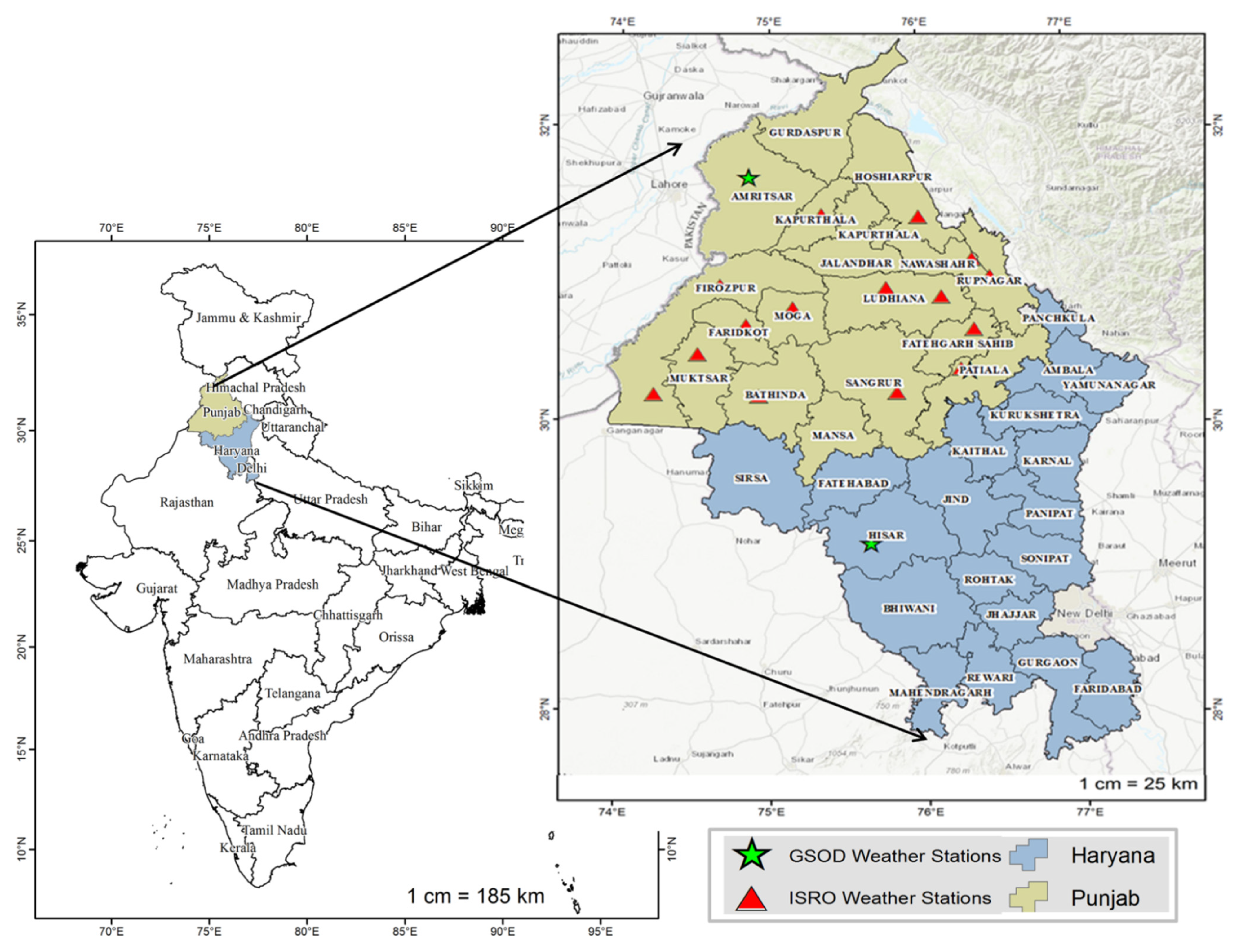
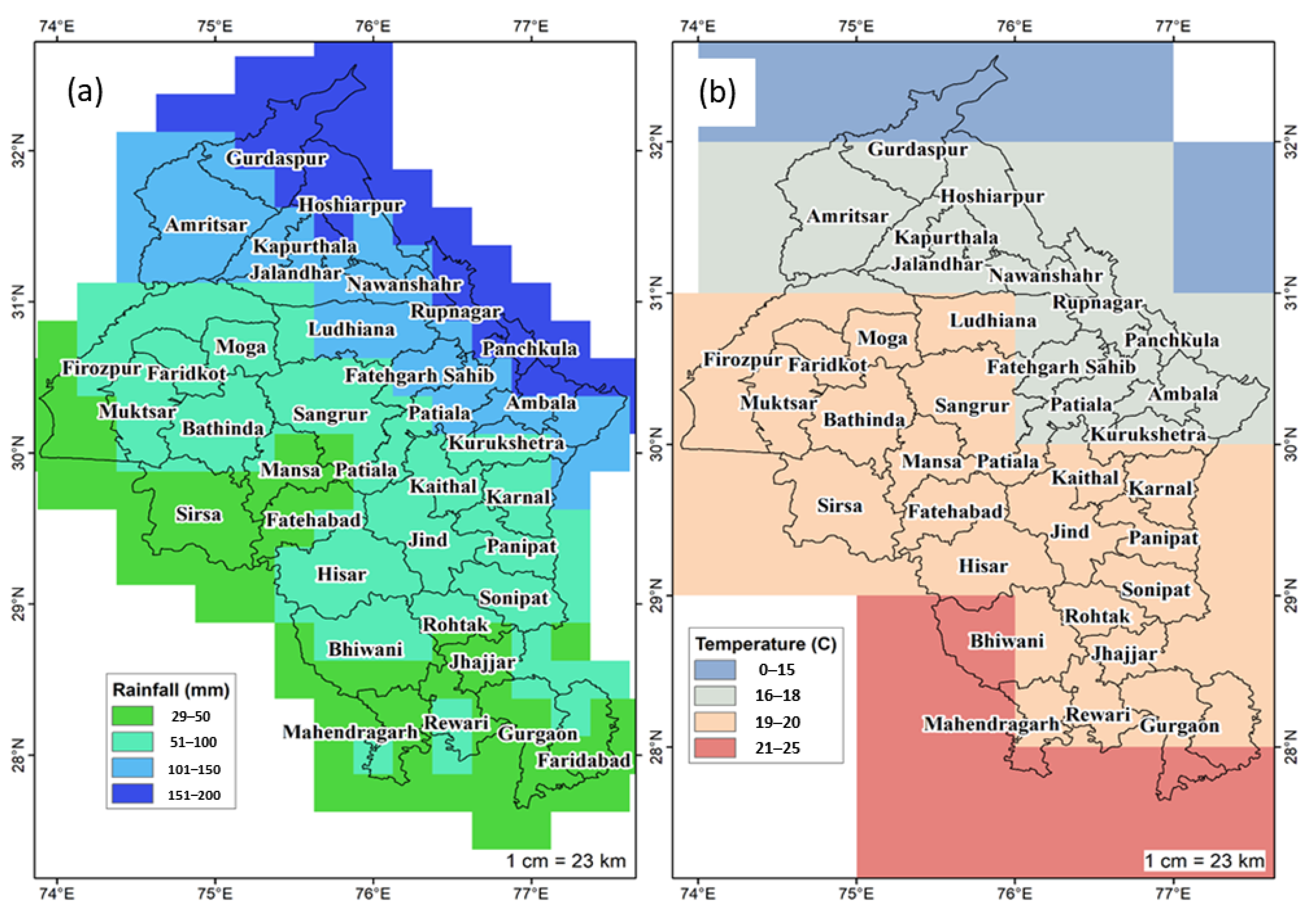
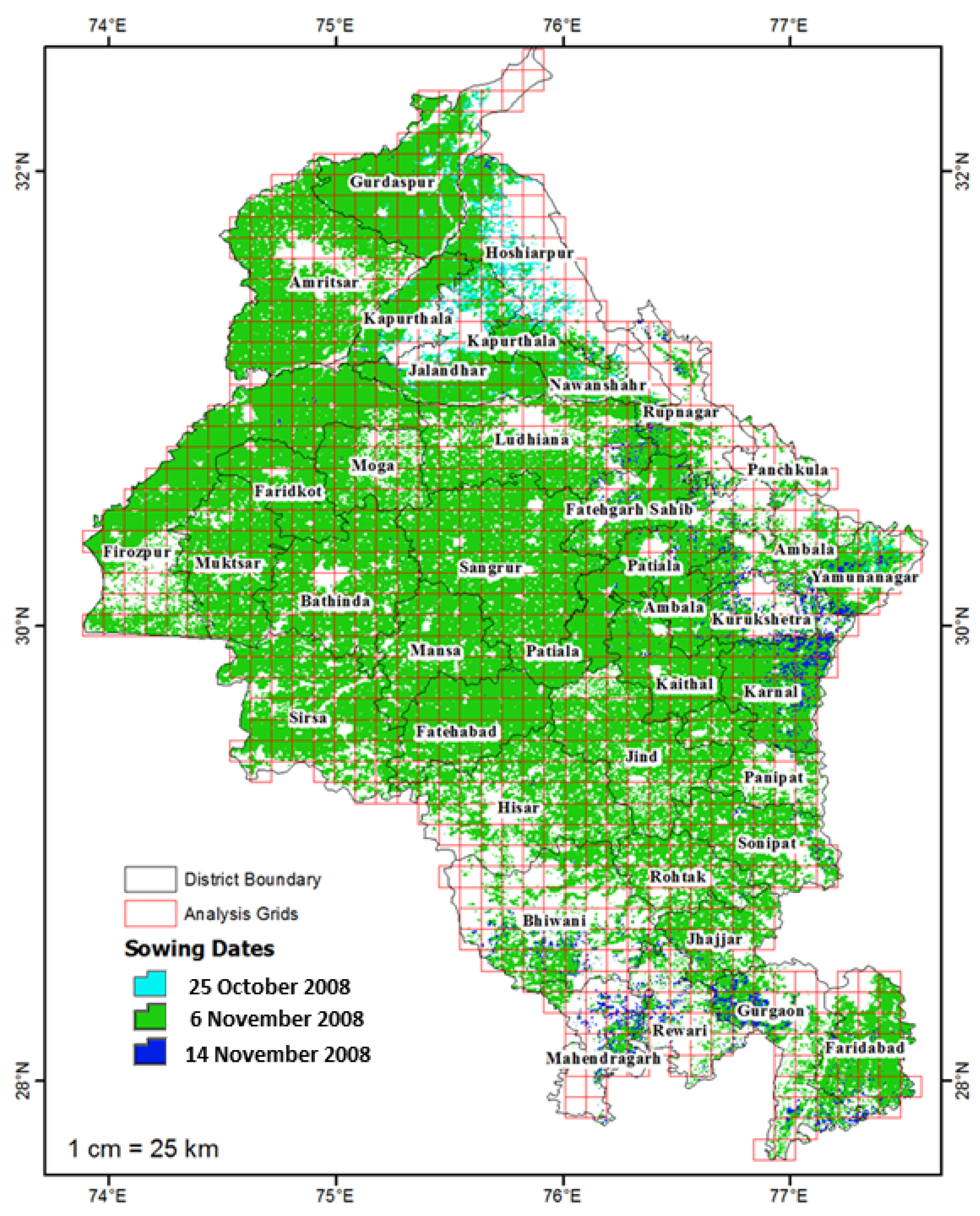

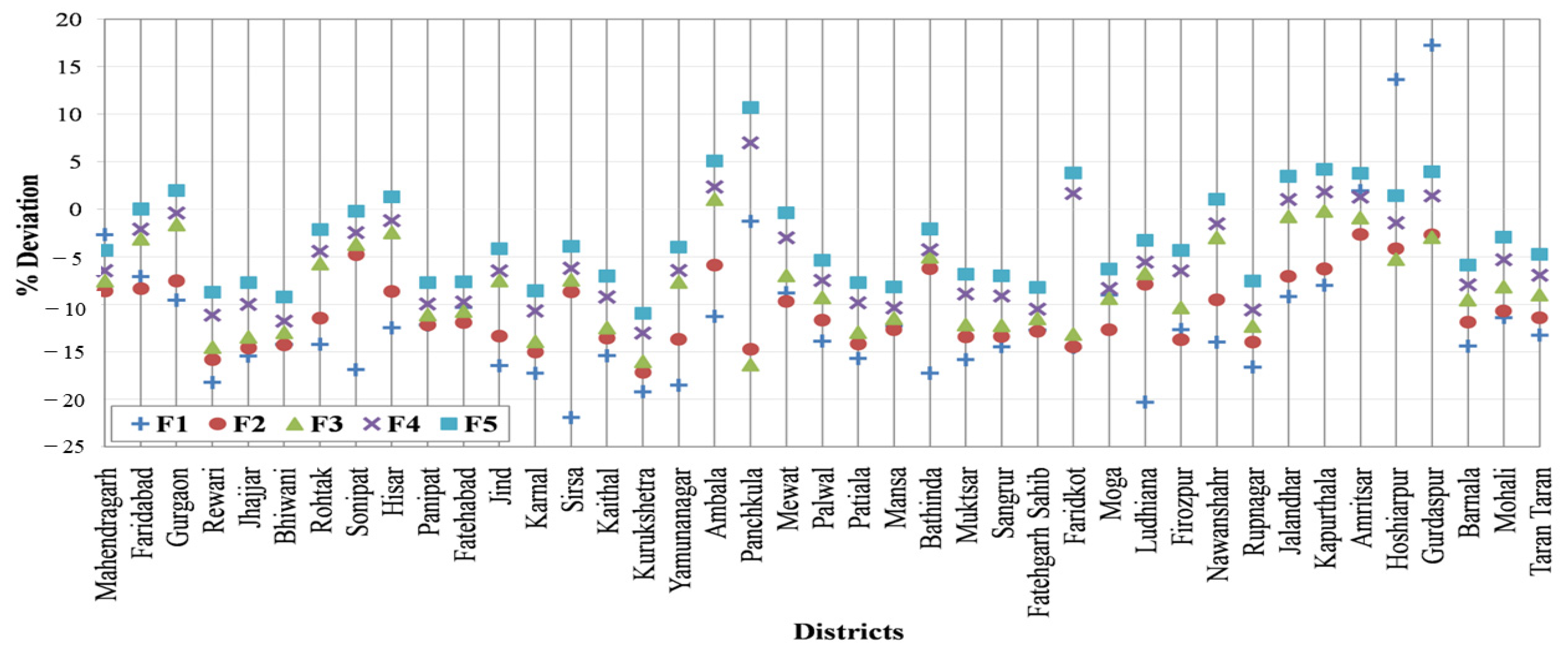
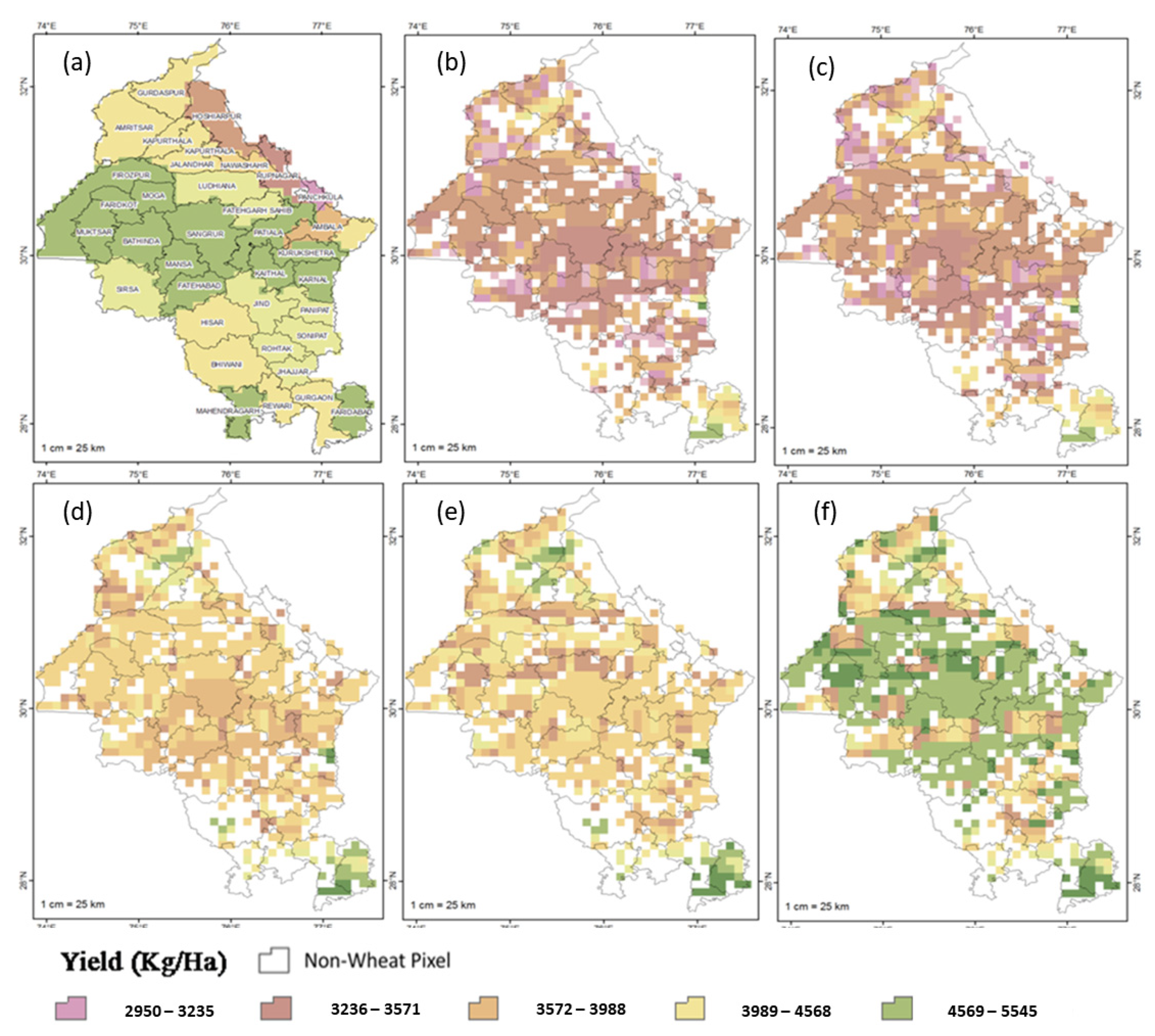
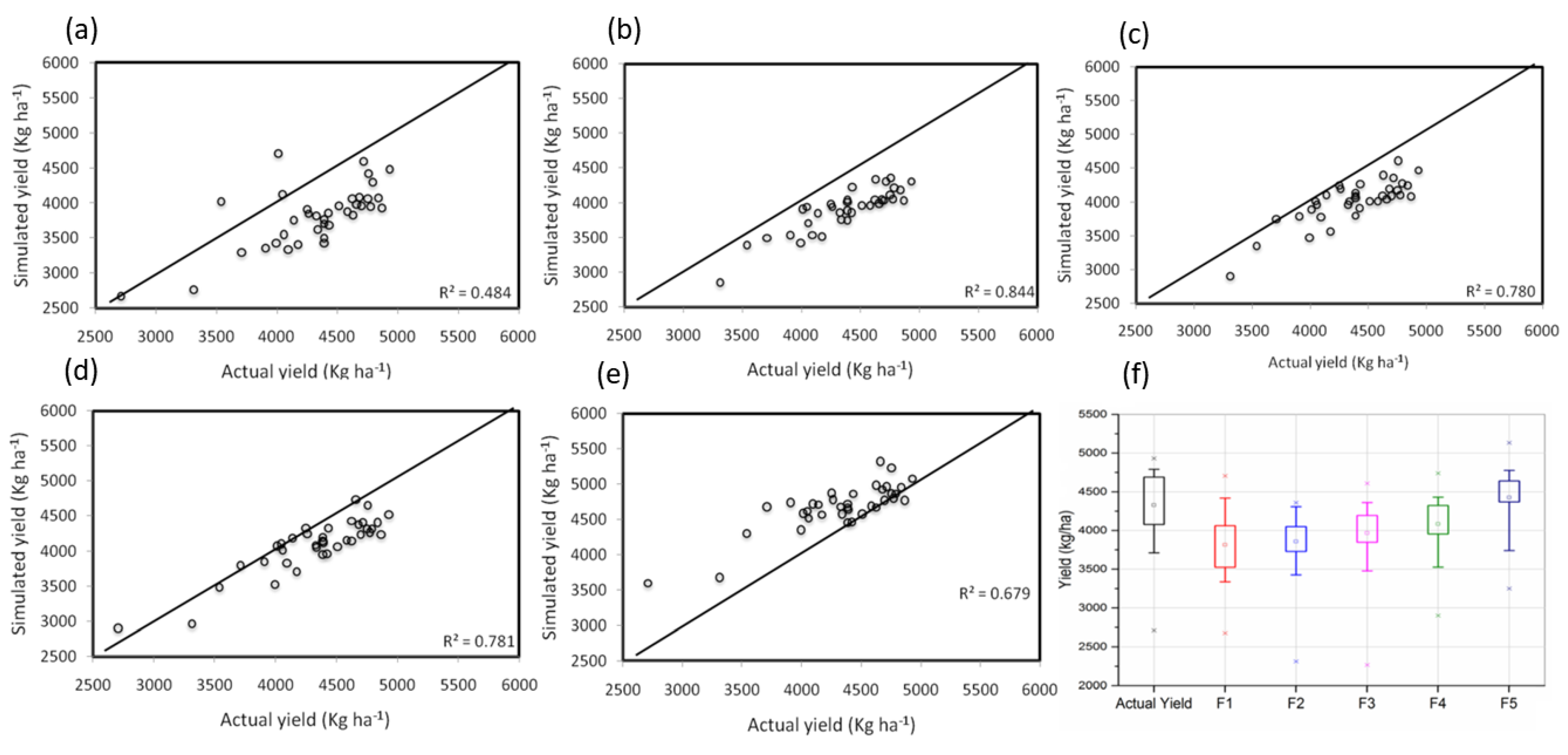
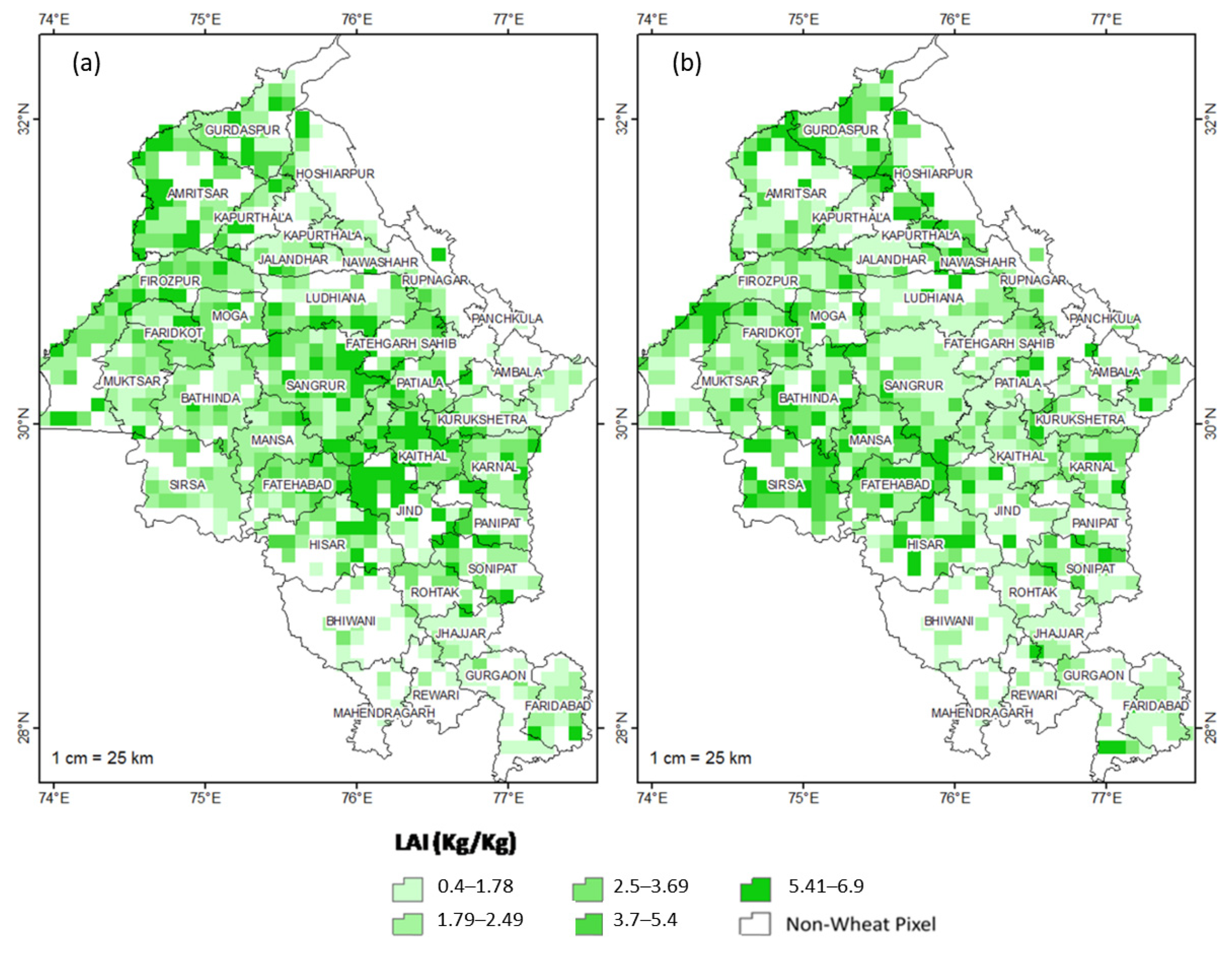
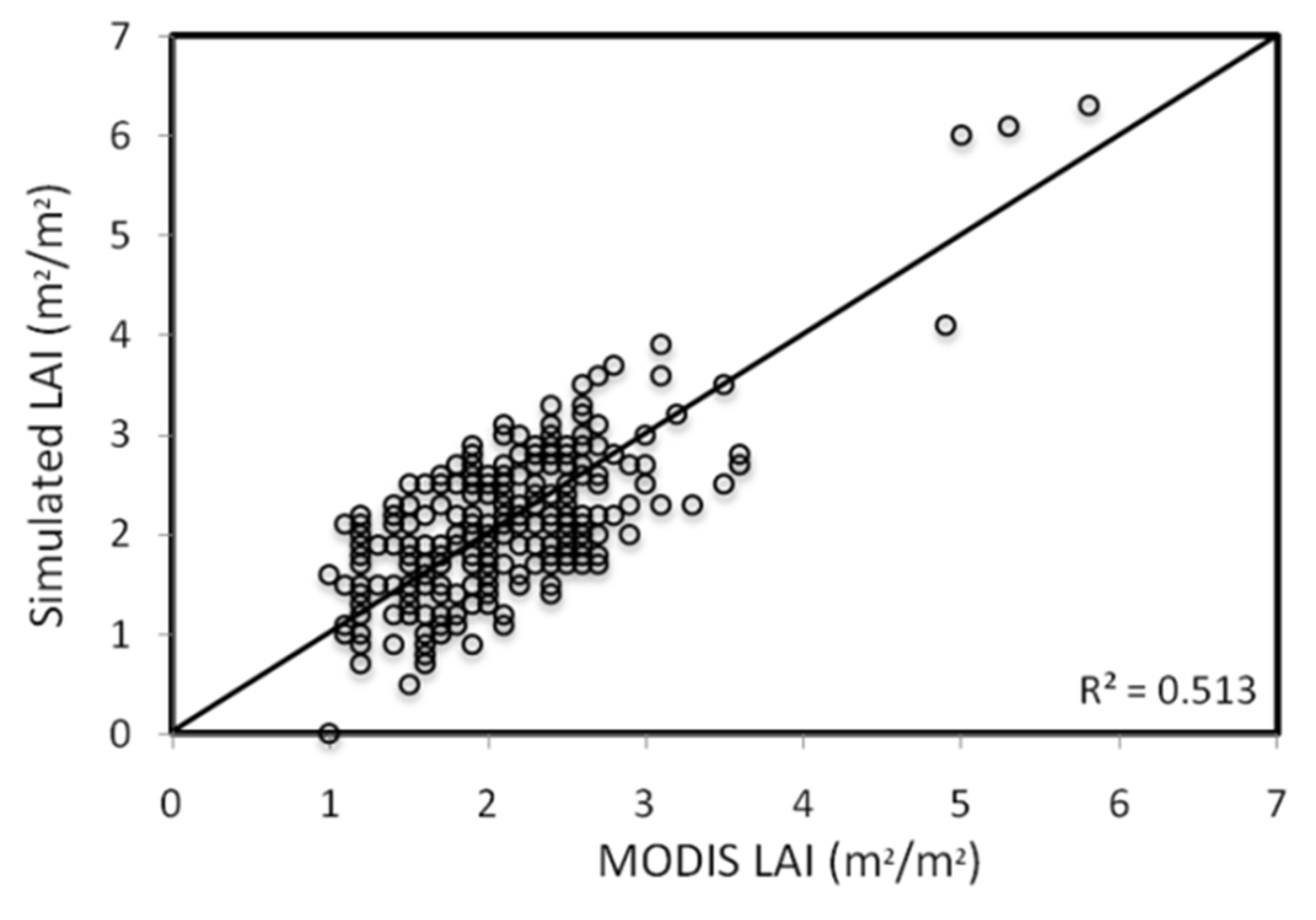
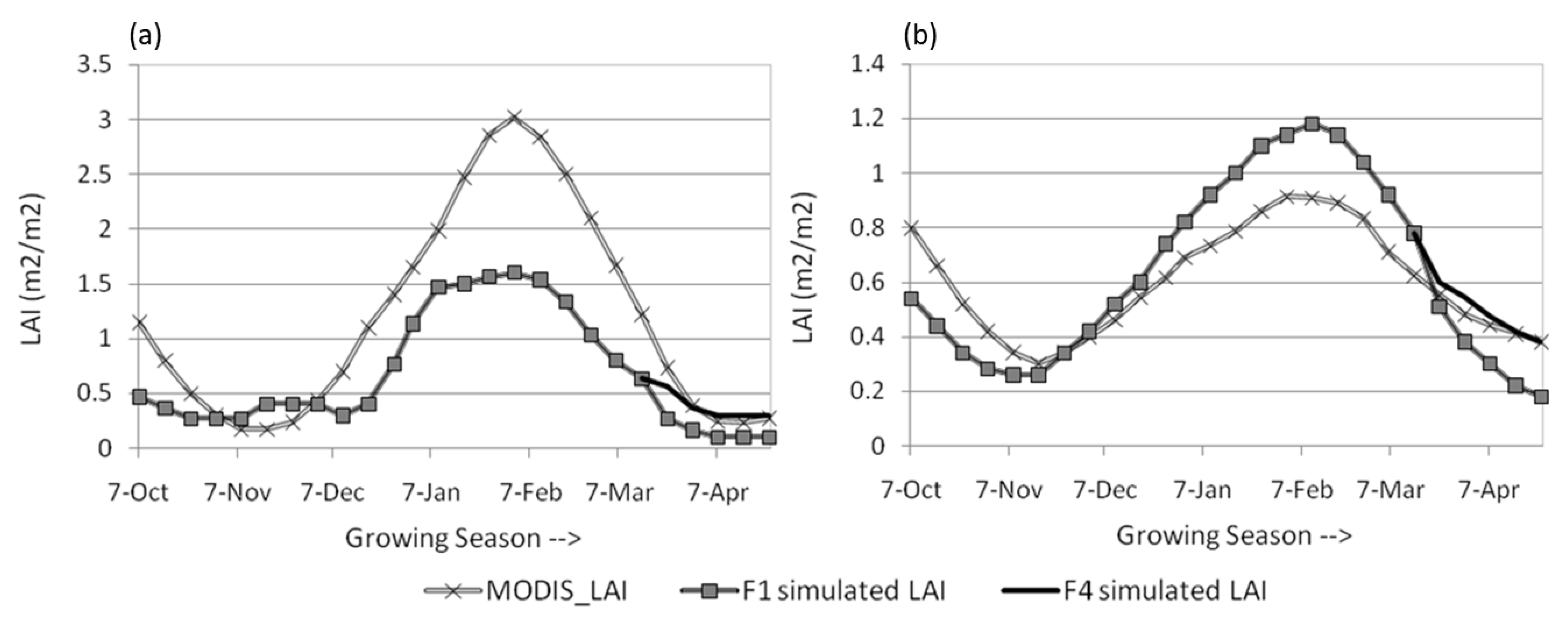
| Physics Options | Convective scheme | Kain-Fritsch cumulus parameterization scheme [27] | |
| Microphysics scheme | Lin scheme [28] | ||
| Planetary boundary layer (PBL) scheme | Yonsei University (YSU) boundary layer scheme [29] | ||
| Longwave radiation scheme | Rapid radiative transfer model (RRTM) [30] | ||
| Shortwave radiation scheme | Dudhia scheme [31] | ||
| Land surface model | Multi-layer Noah land surface model [32] | ||
| Spatial Domain | Domain 1 | 250 km (144 × 68 grid points) | Global coverage |
| Domain 2 | 50 km (722 × 339 grid points) | Asian and African continents | |
| Domain 3 | 10 km (3611 × 1695 grid points) | Northern India | |
| Simulation Protocols | 1 week | 7 April 2009–17 April 2009 | |
| 2 weeks | 31 March 2009–17 April 2009 | ||
| 3 weeks | 24 March 2009–17 April 2009 | ||
| 5 weeks | 10 March 2009–17 April 2009 | ||
| Lead-Time | Maximum Temperature (°C) | Minimum Temperature (°C) | Solar Radiation (MJ/m2) | Relative Humidity (%) | Precipitation (mm) | Wind Speed (m/s) |
|---|---|---|---|---|---|---|
| 1 week | 3.32 | 3.66 | 5.96 | 21.03 | 3.02 | 2.21 |
| 2 weeks | 4.06 | 3.80 | 5.86 | 18.46 | 4.29 | 2.37 |
| 3 weeks | 5.41 | 3.99 | 3.75 | 17.95 | 5.84 | 2.40 |
| 5 weeks | 8.71 | 4.33 | 4.32 | 23.40 | 6.75 | 2.66 |
| Crop Details | Crop cultivar species | PBW 343 |
| Crop duration | Long duration to about 155 days | |
| Maximum crop height | 94.4 cm | |
| Cultural Practices | Planting method | Seed sowing technique |
| Planting distribution | Row-wise method with 20 cm row spacing | |
| Plant population | 70 plants/m2 | |
| Sowing depth | 6 cm | |
| Irrigation Application | Irrigation method | furrow type |
| Total irrigation depth | 70 cm | |
| Stages of irrigation application | Crown root initiation (20–25 days after Sowing (DAS)) | |
| Late tillering (40–45 DAS) | ||
| Late jointing (65–75 DAS) | ||
| Flowering (90–95 DAS) | ||
| Milking (110–115 DAS) | ||
| Dough-formation (120–125 DAS) | ||
| Fertilizer Application | Urea (Ntirogen) | 110 kg/ha (applied at the time of sowing and during first irrigation) |
| Phosphorous | 50 kg/ha (applied initially at the time of sowing) | |
| Pottasium | 40 kg/ha (applied initially at the time of sowing) |
| F1 | Whole-season NCEP-CFSR weather data |
| F2 | NCEP-CFSR + 1-week WRF forecast |
| F3 | NCEP-CFSR + 2-weeks WRF forecast |
| F4 | NCEP-CFSR + 3-weeks WRF forecast |
| F5 | NCEP-CFSR + 5-weeks WRF forecast |
| Parameter Type | Parameters | Parameter Description | Units | Value |
|---|---|---|---|---|
| Genetic parameters of cultivar (development) | P1V | Vernalization sensitivity coefficient | %/d of unfulfilled vernalization | 20 |
| P1D | Photoperiod sensitivity coefficient | % reduction/h near threshold | 80 | |
| P5 | Thermal time from the onset of linear fill to maturity | °C.d (Growing Degree Days) | 610 | |
| Genetic parameters of cultivar (growth) | G1 | Kernel number per unit stem to the spike weight at anthesis | #/g | 20 |
| G2 | Potential kernel growth rate | mg/(kernel.d) | 55 | |
| G3 | Standard stem and spike weight when elongation ceases | g | 1.5 | |
| PHINT | Thermal time between the appearance of leaf tips | °C.d | 90 | |
| Ecotype (phenology) | P1 | Duration of phase end juvenile to terminal spikelet | °C.d | 270 |
| P2 | Duration of phase terminal spikelet to end leaf growth | °C.d | 350 | |
| P3 | Duration of phase end leaf growth to end spike growth | °C.d | 185 | |
| P4 | Duration of phase end spike growth to end grain fill lag | °C.d | 200 | |
| PARUV and PARUR | Photo-synthetically active radiation (PAR) conversion to dry matter ratio | g/MJ | 2.8 | |
| Species temperature response during grain filling | T (base) | Base temperature, below which increase in grain weight is zero | °C | 0 |
| T (opt1) | 1st optimum temperature, at which increase in grain weight is most rapid | °C | 16 | |
| T (opt2) | The 2nd optimum temperature, highest temperature at which increase in grain weight is still at its maximum | °C | 25 | |
| T (max) | Maximum temperature, at which increase in grain weight is zero | °C | 38 |
| Forecast Scenarios | RMSE (Kg/Ha) | MAPE (%) | RD (%) | Agreement Index |
|---|---|---|---|---|
| F1 | 622.52 | 13.35 | −11.53 | 0.59 |
| F2 | 505.23 | 10.77 | −10.77 | 0.77 |
| F3 | 422.82 | 8.33 | −8.27 | 0.82 |
| F4 | 327.75 | 6.26 | −5.35 | 0.86 |
| F5 | 415.15 | 8.05 | 2.77 | 0.41 |
| Growth Stages | Emergence | Crown Root Initiation (CRI) | Tillering | Jointing and Booting | Flowering | Grain Filling | Maturity |
|---|---|---|---|---|---|---|---|
| Growth Period | Nov | Early Dec–Mid-Dec | Mid-Dec–Early Jan | Mid-Jan–Late Jan | Early Feb | Mid-Feb–Mid-Mar | Late Mar–Early Apr |
| Optimal Max Temp (°C) | 20–35 | 21–29 | 20–29 | 18–28 | 19–22 | 20–24 | 28–35 |
| Optimal Min Temp (°C) | 3.5–5.5 | 6–13 | 7–16 | 6–9 | 7–10 | 7–12 | 8–18 |
| Optimal RH (%) | 50–70 | 40–90 | 40–90 | 55–95 | 55–80 | 30–75 | 40–75 |
| Sunshine hours (hrs/day) | 3.5–8 | 4–7.5 | 4–7.2 | 4.5–6.5 | 4.5–6.5 | 9–11 | 9–11 |
| Rainfall (mm) | 0–4 | 4–19 | 4–24 | 15–115 | 40–142 | 20–60 | 0–10 |
Publisher’s Note: MDPI stays neutral with regard to jurisdictional claims in published maps and institutional affiliations. |
© 2022 by the authors. Licensee MDPI, Basel, Switzerland. This article is an open access article distributed under the terms and conditions of the Creative Commons Attribution (CC BY) license (https://creativecommons.org/licenses/by/4.0/).
Share and Cite
Kirthiga, S.M.; Patel, N.R. In-Season Wheat Yield Forecasting at High Resolution Using Regional Climate Model and Crop Model. AgriEngineering 2022, 4, 1054-1075. https://doi.org/10.3390/agriengineering4040066
Kirthiga SM, Patel NR. In-Season Wheat Yield Forecasting at High Resolution Using Regional Climate Model and Crop Model. AgriEngineering. 2022; 4(4):1054-1075. https://doi.org/10.3390/agriengineering4040066
Chicago/Turabian StyleKirthiga, S. M., and N. R. Patel. 2022. "In-Season Wheat Yield Forecasting at High Resolution Using Regional Climate Model and Crop Model" AgriEngineering 4, no. 4: 1054-1075. https://doi.org/10.3390/agriengineering4040066
APA StyleKirthiga, S. M., & Patel, N. R. (2022). In-Season Wheat Yield Forecasting at High Resolution Using Regional Climate Model and Crop Model. AgriEngineering, 4(4), 1054-1075. https://doi.org/10.3390/agriengineering4040066







